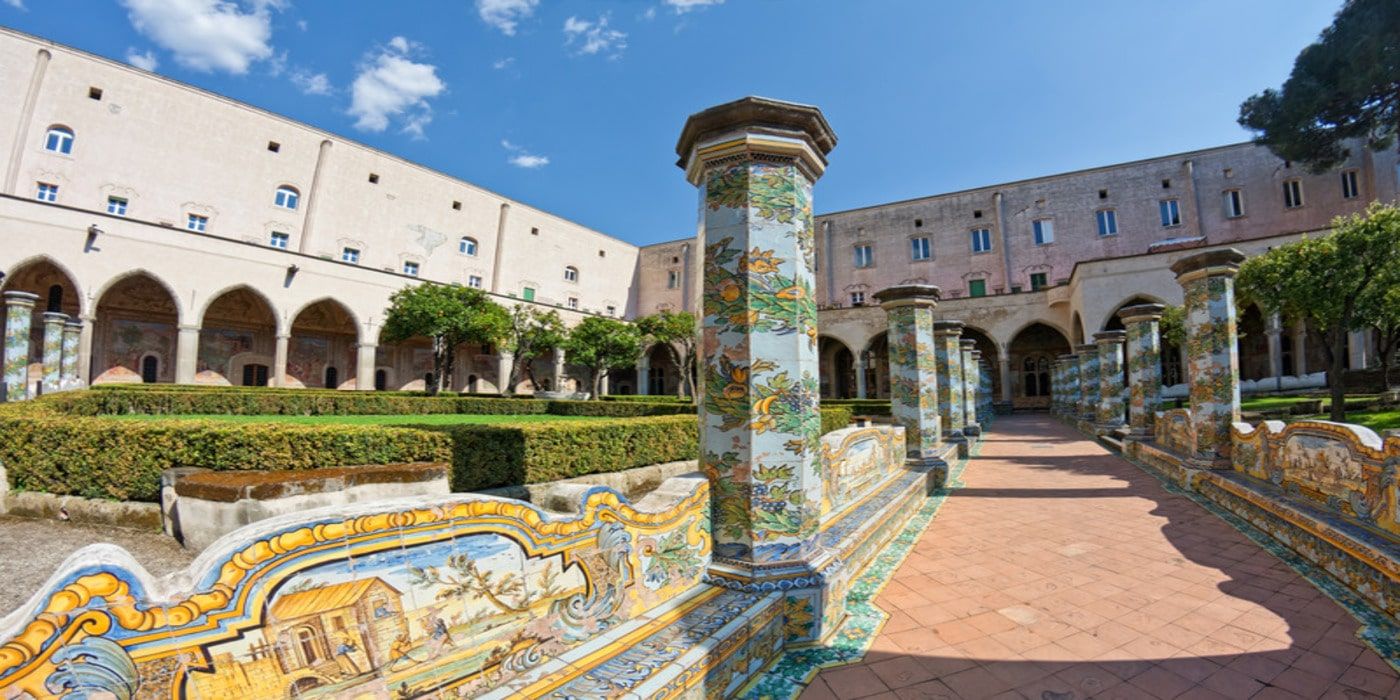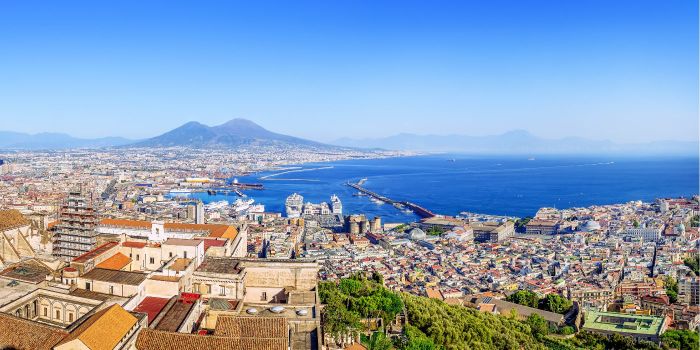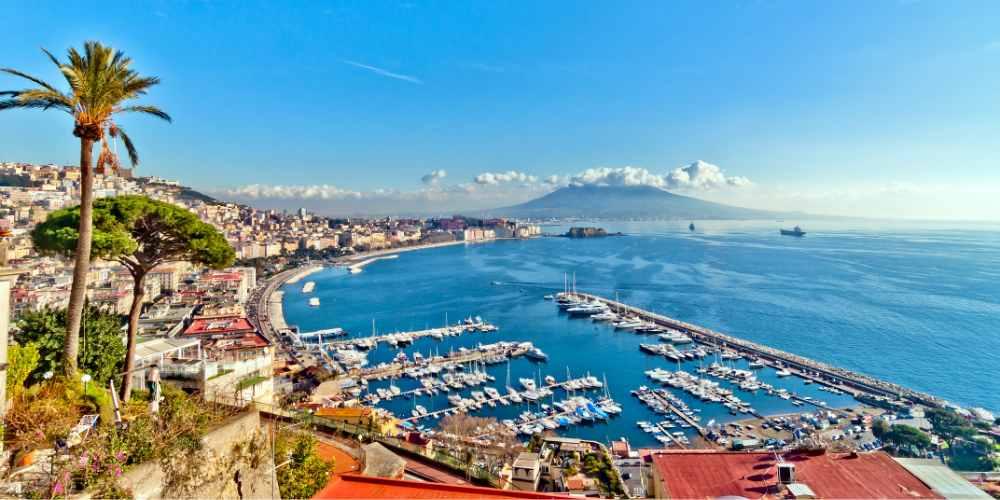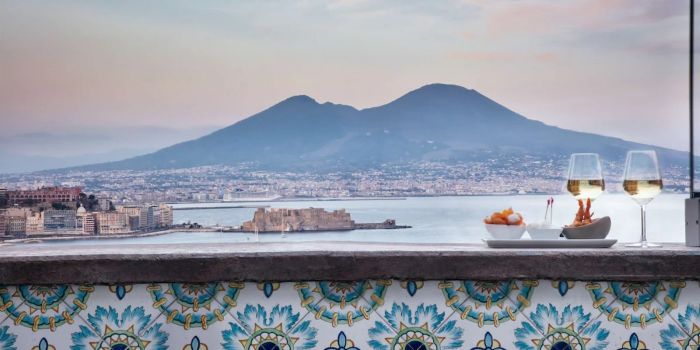Monastery and Cloister of Santa Chiara: Art and Spirituality in the Heart of Naples
Monastery and Cloister of Santa Chiara: the tickets most chosen by travelers
Monastery & Cloister of Santa Chiara: Entry Ticket + Guided Tour
Explore the ancient monastery and see the detailed maiolica tiles
from 40 €

Monastery and Cloister of Santa Chiara in Naples: An Oasis of Peace, Faith, and Beauty
Nestled between Via Benedetto Croce, Via San Sebastiano, and Piazza del Gesù, in the vibrant heart of Naples' historic center, lies an imposing yet discreet building. It may not immediately catch the eye, but inside, it holds an invaluable treasure. The Monastery of Santa Chiara and its Cloister create an important monumental complex, a somewhat lesser-known symbol of the city but still a significant landmark for Neapolitans.
The church dates back to the 14th century and is built in the Gothic style, though it does not stand out as much as many Northern European sacred buildings. It was an important reference point for the Angevin dynasty (many of whom are buried here) and later for the Bourbons, during whose reign it became a renowned monastery. It was precisely in this period that the stunning majolica-clad cloister with its Baroque garden was built, designed by Neapolitan architect Domenico Antonio Vaccaro. The hand-painted majolica tiles, reminiscent of Amalfi ceramics, are the undisputed highlight of this artistic masterpiece.

Discover all other experiences
Monastery and Cloister of Santa Chiara: useful information for the visit
Access to the Church of Santa Chiara is free and on a stand-alone schedule:
7:45 AM – 12:45 PM and 4:30 PM – 8:00 PM.
The access to the rest of the complex is on this schedule:
Monday - Saturday: 9:30 AM – 5:00 PM
Sunday: 10:00 AM – 2:00 PM
Ticket Prices for the Entire Complex:
€7 (full price)
€5 (discounted for under 30 students, teachers and over 65 seniors)
€4 (children aged 7-17)
Free for children under 7 and disabled visitors with caregivers
Monastery and Cloister of Santa Chiara: tips for your visit
How to get to the Monastery and Cloister of Santa Chiara
The Monastery and Cloister of Santa Chiara are located on the street of the same name, at a strategic junction between some of the most characteristic streets of Naples’ city center—V ia Benedetto Croce, part of Spaccanapoli, and Via San Sebastiano — near the stunning Piazza del Gesù.
From Naples' central station, it’s a long walk (about 20-30 minutes), but if you prefer public transport, here are your options:
- Underground Line 1: get off at Università or Dante station. Both stops require an additional 5-10 minute walk.
- Underground Line 2: get off at Montesanto station, with a similar short walk.
- Buses: take Bus 151 to Nuova Marina or Bus R2 and 202 to Corso Umberto, followed by a brief walk.
From Capodichino Airport: Take the Alibus and get off at Piazza Dante.
The best experiences in Naples
Best attractions around Monastery and Cloister of Santa Chiara
all entrance tickets for the most popular Italian attractions
Capri
NaplesPompeii Ruins
NaplesVesuvius
NaplesVeiled Christ
NaplesPaestum Archaeological Park
NaplesRoyal Palace of Caserta
NaplesPoseidon Thermal Gardens
NaplesNaples Undergorund
NaplesFrequently asked questions about the Monastery and Cloister of Santa Chiara in Naples
Are masses performed in the church of Santa Chiara? Are ceremonies held there?
Of course, the schedule is as follows:
Mon - Wed: 7 p.m.
Thu: 6:30 pm
Fri: 7:00 p.m.
Sat: 7:00 p.m.
Sun: 10:30 a.m., 12:00 p.m., 7:00 p.m.
All traditional rites are celebrated there - weddings, baptisms, funerals, etc.
How long does a visit to the compound take?
You can visit the compound during approximately one hour, however, you can explore each section as freely as you wish.
Is it possible to book a guided tour?
Yes, by booking at least 10 days in advance and with groups of at least 25 people.
What style is the complex built in?
The facade of the basilica is in the 14th-century Gothic style, while the exterior bell tower represents a mix of styles, given the various historical periods in which the different levels were built. The cloister dates from 1739.
Who is buried inside the basilica?
21 members of the Neapolitan Bourbon dynasty are buried in the basilica, resting in peace in their private chapel-the last currently surviving portion of the Kingdom of the Two Sicilies! These include as 4 monarchs, including the last king, Francis II of Bourbon. considered the only surviving territorial boundary of the Two Sicilies after the unification of Italy.
The Monumental Complex of Santa Chiara
The Monumental Complex of Santa Chiara was built between 1310 and 1328, a testament to the deep faith of King Robert of Anjou and his wife, Sancia of Majorca, particularly in their devotion to Saint Francis. At that time, the complex included a church, a monastery, and a convent. The monastery housed the Franciscan Friars, while the convent was home to the Poor Clares, whose growing presence likely inspired the church’s name.
The basilica is in the Gothic style, evident in the magnificent rose window on its façade and the pointed shape of its roof. Beside the entrance stands the striking bell tower, begun in the 14th century and completed in the 17th century, showcasing an intriguing mix of architectural styles. Inside, visitors can admire beautiful chapels and frescoes that are well worth a visit.
The complex also includes a Roman archaeological site—a thermal bath complex uncovered after World War II bombings, which destroyed much of the building but also provided an opportunity to explore its foundations. The pre- and post-bombing history is recounted in a 15-minute projection in the Video Room, illustrating the damage from the explosions and the stages of reconstruction. The remains of the ancient basilica can be appreciated in the Opera Museum. Visitors can also explore the beautiful Library, which houses texts and artifacts from the period when the convent was active, as well as an original 18th-century Nativity scene.
However, the main attraction is undoubtedly the majolica cloister, one of four to be still present and the only one available to visitors. This colonnade was designed make the garden more fashionable with its columns entirely covered in painted porcelain tiles. The depicted subjects blend harmoniously with the surrounding environment and vegetation, featuring flowers, plants, and leaves, as well as mythological scenes, folk traditions, and everyday life. One particular column is dedicated to monastic life, depicting a Poor Clare nun feeding a group of cats.
Explore Naples and Its Other Attractions
- Royal Palace of Naples: Located in the splendid Piazza del Plebiscito, just a few meters from the sea, the Royal Palace of Naples is a 17th-century masterpiece (later modified in the 19th century), designed by top Neapolitan architects such as Luigi Vanvitelli, Ferdinando Sanfelice, and Domenico Fontana. It served as the residence for the monarchs of the Kingdom of the Two Sicilies in the 18th and 19th centuries, hosting Spanish and Austrian viceroys, the Bourbon kings, and the Savoy family after Italy's unification.
- Castel dell’Ovo: This enchanting fortress sits right on the water in the famous Bay of Naples, on the Megaride Islet. This is an acient Norman stronghold and its name comes from a legend about a magical egg (ovo is an old way to say uovo, egg) hidden within its walls by the poet Virgil (yes, the one from The Divine Comedy), which was believed to support the entire structure.
- Maschio Angioino (or Castel Nuovo): This castle is home to the Neapolitan Society of National History and the Naples Committee of the Italian Risorgimento Institute, as well as the Civic Museum. It is an enduring symbol of Charles of Anjou’s power, who, after defeating the Swabians, became King of Sicily and moved the capital of his kingdom from Palermo to Naples in 1266.




















Denise Penna
Among the countless churches in Naples, the Monastery of Santa Chiara and its famous Cloister stand out as a unique artistic gem in the heart of the old town.